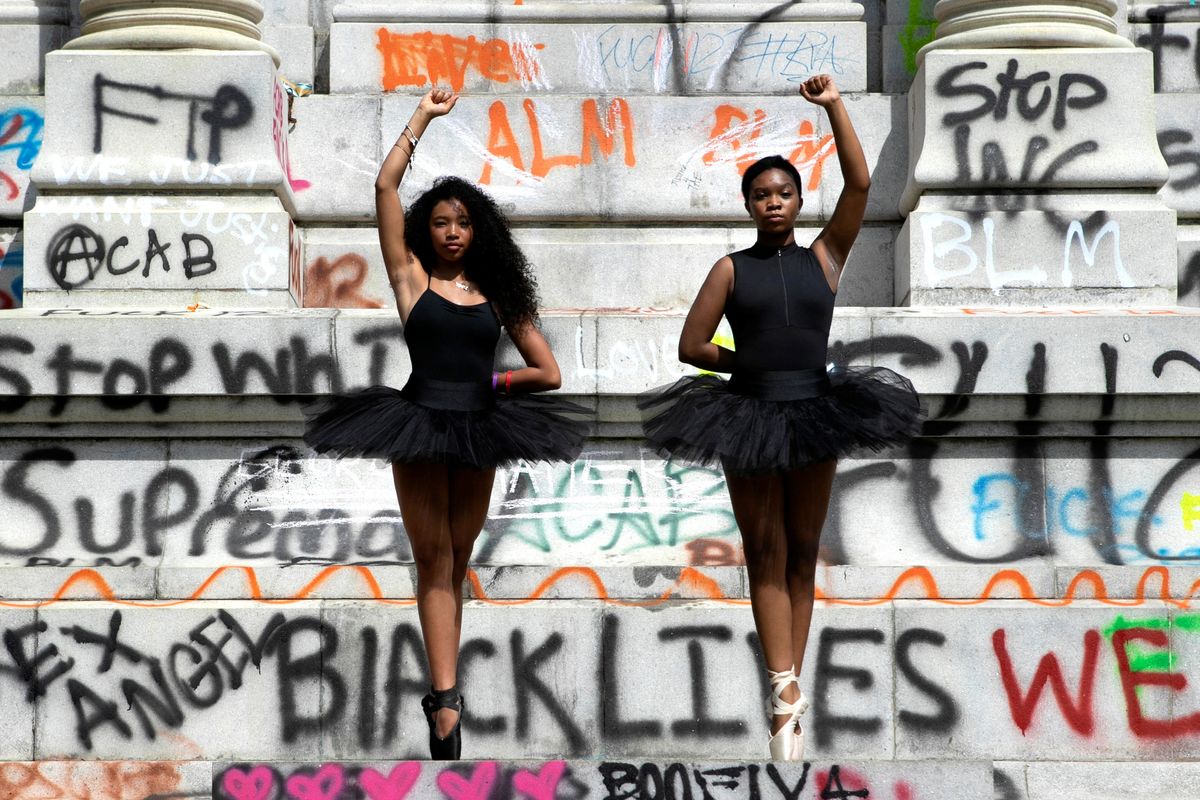Meet Ava Holloway and Kennedy George, the Teens Whose Photo Dancing On a Confederate Monument Went Viral
Last month, a photo of two 14-year-old Black ballerinas—Ava Holloway and Kennedy George—dancing on Richmond, Virginia’s Robert E. Lee monument lit up social media as Black Lives Matter protests seared through the U.S. The dancers, clad in all black, stood balanced in sous-sus with their fists raised while the structure awaited its still-anticipated toppling.
Holloway had decided to pose for photos in front of the statue after Virginia governor Ralph Northam announced its pending removal. When her mother, Amanda Lynch, uploaded the images to Facebook, a friend of local photographer Marcus Ingram asked if Lynch and Holloway would be interested in professional photos.
Upon arriving to shoot with Ingram the following morning, Holloway ran into her longtime friend Kennedy George, who was preparing for a group shoot with Holloway, other dancers and a teacher from their studio, Central Virginia Dance Academy, scheduled for later that day.
Reuters photographer Julia Rendleman spotted the dancers at the monument and photographed them. After Reuters tweeted the shot, it received thousands of likes and shares on Twitter, Facebook and Instagram.
Dance Magazine
spoke with the dancers about the shoot, their activism and what they want to see in the dance world.
What were some of your thoughts as you were dancing in front of the statue?
George: I felt empowered, like I was part of a greater cause; a bigger movement.
How have your lives changed since posing for the images?
Holloway: Since then, we’ve done a lot. We’ve been interviewed, taken headshots, we started a nonprofit with the other girls in the photos, a scholarship fund for dancers who look like us.
Can you talk about your nonprofit,
Brown Ballerinas for Change?
Holloway: The founders of it are me, Kennedy, Sophia Chambliss and Shania Gordon. A big part of it is the Ava Holloway & Kennedy George Scholarship Fund. It pays for some of your tuition for dance and dance expenses if you can’t pay for them yourself. Right now, we’re working on the audition process for that and maybe in the future, we’ll add ambassadors. Our partners are Brown Girls Do Ballet and another local organization, Miracles in Motion, that we’ve both worked with in the past.
George: The nonprofit’s mission is to create advocacy, social justice, and to increase participation of underrepresented populations in ballet.
On the Brown Ballerinas for Change website, you both mention a desire to work in medicine. Is there a connection between your work as rising Black dancers and activists, and your medical aspirations?
Holloway: I think we both definitely believe that there need to be more people that advocate using their gifts and what they’re good at. I’m really interested in science, and we both dance, obviously, so if we use dance as a way of protest, you can pretty much use anything. In the future, hopefully, being in the medical field can also help me advocate. And you don’t see many doctors that look like me, so I think that will also help it to be diverse in the future, which is also part of a bigger picture.
George: I think the connection with medicine is giving back to the community and helping people out, helping the less fortunate.
What changes would you like to see in dance or the arts?
George: I would definitely like to see more different varieties of people.
Holloway: Hopefully ballet can change altogether and we can go away from these stereotypes we’ve had for years.
George: And also to make things easier for everybody, not just one group of people; to make things more accessible for everyone.
Do you have any advice for other young people who want to advocate for social change?
George: My advice would be just to know who you are, know what you stand for and be confident in that. And know that you are supported. Someone out there supports you. You are, and can be, just as powerful as anybody else. Use that, and surround yourself with people you know will help you and love you.
Holloway: I say, speak up and don’t be afraid to say what you need to be heard. We’re the future, and whatever you do, we’re going to see in the future. Hopefully, we’ll help change the ideas we’ve had for centuries. I definitely think our generation will be the one to change the world. Even though every generation says that [smiling], I definitely think we can do it.




